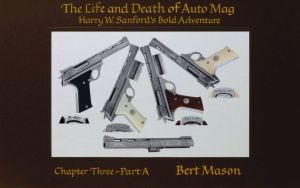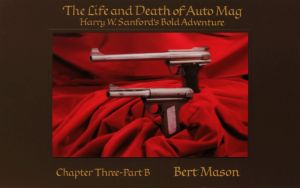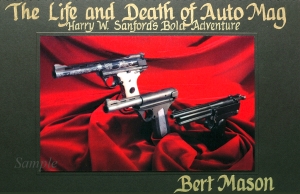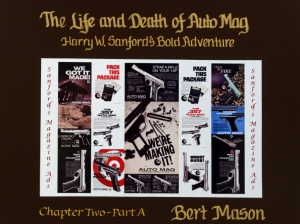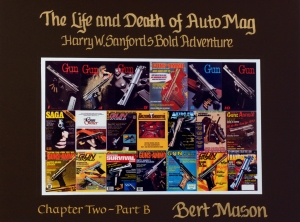Contact
Links
Guestbook
Hi, I'm Bert. This Auto Mag website will be a fun and educational place for all. I've been working hard, lo these many past years, on a monumental book about Harry Sanford and his guns. When indicated, your help will be very much appreciated. Enjoy!
Well, everyone 15 years of putting together The Total Book Of Auto Mag is finally finished with the completion of chapter 3 parts A and B. The 2 volumes include Sanford's production of the B and C series guns, standard and non-standard barrels, deals with Lee Jurras for his custom series, Lomont's Auto Mags and his speciality barrels and many after aftermarket products for the Auto Masg. You will find photographs, documents, and also those important things that should have been in chapters 1 and 2 but have just recently come to light. Extraordinary information and gobs of interesting tidbits are shown.
Lot's of reading enjoyment will be yours. Finally here it is. Don't overlook the special DVD of bonus content on the back of chapter 3, Part B.
Chapter 3, like chapter 2, will be presented in 2 parts, A and B. They will be sold separately or together for a bit of a price break!
The single
copy of the 8 1/2 X 11 is $400 including shipping and handling for the
U.S. for
part A or B. The 11
X 17 is $700 including
shipping and handling for the U.S.
The cost as a pair, the whole Chapter including parts A and B is: $750 for the 8 1/2 X 11 size and $1300 including shipping and handling for the 11 X 17 size. Shipping is through USPS Priority Mail.
Now that the book is complete we have a special deal for those of you who have been waiting to purchase the whole book at once. The price for the 8 1/2 X 11 inch whole book, all 3 chapters at once, is only $1700! That is a savings of $300. The whole book in the 11 X 17 inch size is a mere $3000 for a savings of $500! As with the individual chapters that price includes shipping and handling. The information for chapter 1 and 2 is near the bottom of this page so scroll down and check it out.
A few years back, we brought to you a calendar spotlighting each of Lee
Jurras' specialty Auto Mags. That 12 gun
presentation included the Model 100 to the newly acquired Model 600, CONDOR,
plus the .41 caliber Metallic Silhouette!
That calendar presented to you the only known total collection of
Jurras' specialty Auto Mags!
We will now make available the new 2017 Auto Mag calendar for sale
during the second half of November, 2016, or sooner if possible!
This calendar will highlight serial numbers "1" and the last
number of any Auto Mag series made available for sale by the factory. Of course there are other "1"s and
the last of many existing series! The
catch is to find. and purchase them.
Returning to the present, be the first to purchase the 2017 Auto Mag
calendar for $39.00 plus shipping and handling.
The 2018 calendar will present 12 Auto Mags engraved by the Japanese
engraver, "Ogawa" for Sanford's factory. We will also show for the first time a
here-to-for unknown "Ogawa", which sports the rare 120% engraved
coverage. This 2018 calendar will
probably be made available near the beginning of 2017. Enjoy!
I have also produced a wonderful, large, 44 X 33 inch poster of Max Gera's original XP Auto Mag. The poster is available for sale right now for $79 plus shipping and handling.
Don't Kill The Messenger
My dear readers read on and follow this complete thread as it unfolds.
Patrick Henry III
I met Patrick Henry III in the first week of September 2015. He had just purchased the last remaining batch of parts and tooling for the Auto Mag from Walter Sanford.
After our first meeting, we came to a financial agreement in which I allowed him to use my totally redesigned upper assembly for the Auto Mag X, of which I had built a working prototype about a year earlier and also the much simplified lower assembly, on which I was working at the time.
A couple of weeks later, we had a meeting at my house with the owner and engineers of Stealth Arms, a machine shop that Patrick Henry III had contracted to produce an initial run of pre-production guns. Everything went smoothly and when they left, I felt confident that they could actually do the job.
Over the next few months, I worked on several exploded view models of the Auto Mag X, as Patrick Henry III called the new gun. I was in regular communication with the shop engineer, Steve Elsass. The production tooling and parts for the initial run were coming along on schedule.
Sometime in December or January, Patrick called me on the phone and told me that “a gunsmith” that he knew, had suggested that we modify the position of the cocking notches on the hammer on the Auto Mag X in such way as to allow the hammer to follow the bolt and not engage the sear until the hammer was about half-way down. By doing this, he claimed, the time of the hammer fall would be greatly reduced and it would greatly improve on the accuracy of the gun.
I explained to him that such modification would make the hammer engage the sear at almost full speed, and very likely, it would damage the sear after only a few rounds and turn the Auto Mag X into an uncontrollable full auto pistol (not recommended on a .44 Mag).
The marginal improvement in the lock time was definitely not worth the unpredictability and lack of safety that it would cause. Patrick Henry III did not bring up this subject again.
I continued to work on several other computer models and tooling, while Stealth Arms was making steady progress and running pretty much on schedule.
Sometime in February or March, during one of our phone conversations, Patrick asked me if I had any ideas for new products related to the Auto Mag. I told him that I was working on a .22 rimfire conversion unit that consisted of a barrel insert, a straight blow-back bolt and a specially designed magazine. I thought this could be a marketable item for Auto Mag owners. We discussed it in length, I sent him a computer model of the barrel insert and he gave me the go-ahead to complete the design after I finished the current work.
Sometime in March I received a call from Steve Elsass, telling me that they couldn’t torque the barrel to the receiver to my specs (480 to 520 foot pounds) and asked why did I specified such a high torque. I explained to him that it was the standard torque for a 7/8 – 20 thread according to the ASME torque charts. He responded that they had tried to do it but their torque wrench broke, and showed me the picture of a broken wrench about 18 inches long. I told him to buy the correct size wrench, it is about 5 feet long, and they would have no problem. A few minutes later, Patrick Henry III called me and told me that “the gunsmith” that he knew, claimed that there was no need for such a torque. I responded that I trusted the American Society of Mechanical Engineers more than “the gunsmith” that he knew. I immediately sent him a link to a tooling supply catalog showing the correct size wrench and told him to buy it and have Stealth Arms torque the barrel properly, according to my specs.
Mark LovenFuckingDale All Over Again
I completed the simplification of the lower assembly by eliminating 12 unnecessary parts and modifying the frame so it could be machined from billet. I sent the finished computer models to Patrick Henry III towards the end of March.
In early April I received an email from him titled “Lower Assembly Improvements”. The email contained some very crude hand sketches of “improvements” that he wanted me to incorporate in the design:
The first one was to modify the magazine follower to use a quick detachable hold-open pin. This was supposed to make it easier for the owner to remove the follower and magazine spring for cleaning. Other than the fact that it would require a special tool to push the follower all the way down while leaving one hand free to pull the pin, I told him that it probably wouldn’t hurt.
The second “improvement” was to replace the trigger torsion spring with a coil spring that was to be contained inside the trigger stop screw. This would have required drilling a hole inside of an 8-32 screw that has a minor diameter of an 1/8 of an inch to contain the spring. For all practical purposes, the spring would have to be no more than 1/16 inch in diameter! This of course, didn’t even consider the fact that in the production Auto Mag, the trigger spring and trigger stop rest against the magazine release latch. Just imagine: A loose 1/8 inch long end of a 1/16 inch diameter coil spring pushing against the curved surface of a 5/16 inch diameter rod that moves about an 1/8 of an inch from side to side...
I explained to Patrick Henry III that besides being a bad idea, the new simplified lower assembly used a different type of spring that served both as trigger and trigger bar spring.
Saving the best for last. The third “improvement” consisted of welding the recoil rods to the cocking piece and securing the recoil springs in place with nuts on the front of the recoil rods, essentially moving the threads from the back to the front of the recoil rods. This supposedly would solve the “problem” of the recoil rods loosening occasionally because of the Helicoils.
Anyone with a semblance of a functioning brain can see immediately the pitfalls of this arrangement.
Moving the threads from the front to the back of the rods changes nothing as far the rods becoming loose. The rotating forces of the recoil springs would still act against the bearing surface of the rods and under the right circumstances would still loosen (or tighten the rods).
Damaging a recoil rod would now require you to throw away the entire cocking piece.
Just imagine trying to assemble the recoil springs. You would have to compress the unsupported free end of the spring and then slide the front nut in place and start threading it to the recoil rod before the spring can jump out and go right through your eye!
Finally, the front nuts would necessarily take more space than the fixed head of the current recoil rods reducing the already marginal space available when the bolt is at the end of its travel and the springs are fully compressed.
I tried to explain all this to Patrick Henry III, including the fact that the new upper assembly no longer used the Helicoils and that the “solution” was purely academic.
At this point my patience was wearing thin and I asked him directly, "Who is coming up with all these idiotic ideas?" He finally told me that “the gunsmith” was a Timothy Bell, a friend of his, and that he was a very knowledgeable person and that he wanted me to talk to him and to be nice to him. I told Patrick that I had no intention of wasting my time talking to someone who kept on suggesting idiotic changes, clearly for the sole purpose of being able to say, “That was my idea”!
Testing
Around the middle of April, Stealth Arms started test firing the first prototype that they had completed. It worked very erratically.
Since the beginning of the project we had weekly online meetings through a totally unreliable “GoToMeeting” website. We spent at least 50% of our time trying to get the “meeting” to work as intended. It rarely did. On the first meeting after the test firing, the people from Stealth Arms showed some videos and photos of the test firing. The problem seemed to be mostly magazine feeding related, because they told me that that the bolt locked back on the hold open properly when fired with a single round, indicating that the bolt was cycling correctly.
Lo and behold... This time we had a new member on the online meeting. You guessed it, “the gunsmith” Timothy Bell was there to solve all our problems with his expertise... And of course, all he wanted to do was to talk about his welded recoil rods and easy disassembly magazine follower.
I cut him off and told him that I did not want to hear about his bullshit. We were there to determine why the gun wasn’t feeding, not to hear how clever he was.
They did about another week of tests, firing about 500 total rounds without solving the problem. At this point I asked them to send me a complete set of parts so I could examine and assemble and test it myself. Well, they did, sort of... Even though they were making parts for about a dozen upper assemblies, they had only completed enough parts for two. They had fitted, assembled and fired both of them. Fortunately the assembly they sent me was fired only a few times.
Around the middle of May, when I received the assembly, I was very impressed with the finish and workmanship of the parts. I spent a couple of days examining every detail and fit of the new upper. The headspace was correct. I found numerous minor discrepancies, sharp corners, and rough surfaces that needed to be smoothed out for proper functioning (see Kent Lomont's Tuning Tips for the Auto Mag).
The only thing that got my attention was a very visible mark on the inside of the slot for the takedown lever, which acts as the forward stop for the barrel extension. My specs called for the barrel extension to be machined from 4140-PH alloy (28-32 Rockwell C), and once finished, to induction harden a 1 1/2 inch area around the locking lugs to 44-48 Rockwell C.
My first guess was that maybe they had heat-treated too small of an area and didn’t quite reach the stop bearing surface. In the next few days or so, we had another online “GoToMeeting”. I had a well prepared report of all that I believed needed to be done. When I brought up that the heat-treating of the lug area was not large enough to include the stop face of the barrels extension... Someone on the Stealth Arms group said, “We never heat-treated the barrel extension”.
My drawings clearly stated how I wanted the barrel extension heat-treated and I had also discussed it in detail with Steve Elsass.
I couldn’t believe that someone could be so stupid as to actually fire over 500 rounds of 40,000 psi ammo in a non-heat treated gun. No one knew who decided that the receiver didn’t need to be heat treated. I told them to take their gun apart and examine the locking lugs, and if they were not too badly damaged, to clean them up and have the barrel extension heat treated to my specs. I would do the same thing with the one they had sent me.
The next day I set the barrel assembly on my barrel mounting fixture and clamped my barrel wrench to remove the barrel... Well, I was able to unscrew the barrel by simply turning the wrench with my hand, without the need of my usual 3 foot pipe. I seriously doubt that the barrel had more than 25 foot-pounds of torque.
This time, I went into a rage. I called Patrick Henry III and demanded to know why they refused to follow my instructions and who was the idiot responsible for not heat-treating the barrel extension and not torquing the barrels to my specs? His answer, “I don’t know”. By now, I had a pretty good idea of who the idiot was...
I had the barrel extension heat-treated by my local shop and reassembled it after setting the barrel back 1 turn to get the proper torque.
At this point, I found several other problems. My design called for the bolt rotating pins to be inserted from the inside of the frame ring with a slip fit into the ring pin hole and held captive between the bolt and the inside of ring by a .006” shoulder. My assembly computer models show this quite clearly. Someone assembled the pins from the outside of the frame ring press fitting them in place. This of course, made the small diameter of the pin, perform the bolt rotation and guiding of the bolt and throw the timing off.
For some reason, someone changed the shape of the Disconnector slot from “V” shape to “Half-Round” and this causes the Bolt Tappet to hang.
Also, when they pressed the pins in place, someone gouged the camming surface of the bolt. And finally, some genius decided to put a substantial radius on the front of the lower bolt lug (the one that strips the round from the magazine)... That of course increased the possibility of ride-overs.
In spite of these deviations from my design, the gun worked fine when shooting towards the ground. It would only malfunction when firing horizontally. This was an old problem with the Auto Mag and it even had a name: “Follower Bounce”. When firing, the sharp rise of the gun under recoil created a hesitation of the column of ammunition in the magazine, essentially compressing the magazine spring, slowing down the next round's rise into position and causing the bolt to completely skip over it. Over the years, the cure for this problem had always revolved around using heavier and heavier magazine springs, to the point of making the magazine very difficult to load and of course, creating other problems due to the very high friction of the ammunition column against the bottom of the bolt.
Well, I decided to solve the problem once and for all. I designed an “anti-bounce” follower. Basically the follower can only move upwards except when being loaded. This should solve the problem. While I was at it, I also designed a constant force spring for the magazine to make it easy to load. It takes the same pressure to insert each round, regardless of the number of rounds in the magazine.
As soon as I had a satisfactory computer model of the new magazine, I started making a prototype for testing.
Benedict Arnold
Around the first week in June, when I was almost finished with the new magazine, I saw a new post on the TheNewAutoMag.com website, showing the testing of a rather crudely made .22 rimfire conversion for the Auto Mag. In this post, Patrick Henry III proudly announced that it had been designed and made by... you guessed it... Timothy Bell. Not once was it mentioned that it was based on my concept and that he had actually commissioned me to finish it a few months ago.
I found it hard to believe that anyone would be so stupid to think that he could stab me in the back, pretend it didn’t happen and that I would let him get away with it. Especially, since I have the ONLY working prototype of the new Auto Mag X in my hands (they kept on firing the other one without ever heat treating it).
I put this entire fiasco online and it didn’t take me long to trick Patrick Henry III into admitting in writing that he had indeed given me the go ahead to complete the .22 conversion.
I found this whole chapter so aggravating that I decided to put the entire project on hold for a couple of months and finish some home remodeling that I had started earlier.
I will resume the final testing of the new
Auto Mag X
in a couple of weeks, and then will start some serious re-negotiating.
This
time, I am fully aware that this Patrick Henry has a Benedict Arnold
alter-ego.
P.S. I may have removed Max Gera's letter temporarily from my website, but it will appear in bold letters in chapter 3 of my book along with the email shown below.
Dear
Mr. Bert Mason
I was really surprised that you printed the Gera comments on your
website (www.automagheaven.com)
regarding me. The information you posted is mostly false and the rest
is skewed out of context to try and make himself look good and to cause
anyone visiting your site to have a less than a favorable view of me as
a gunsmith which directly affects my income.
I have contacted an attorney specializing in libel cases in your area
and if the comments are not removed immediately I will be forthwith in
bringing a libel law suit for actual and punitive damages against you
and your internet carrier ( Whidbey Telecom ) since you personally
posted the information for Max Gera on your website without any factual
knowledge on your part. For your information I only attended one “Go to
meeting” with Max Gera and this meeting was recorded with everyone’s
knowledge so I am capable of proving my points in a court of law.
I am notifying you of my intentions as suggested by my attorney. I
really hate to sue but certainly will if this is not remedied within 48
hours.
Kind
regards
Here is an email from Ian about this:
Hi Bert,
Just catching up with your site and would just like to offer
my support as one of the recognised AutoMag history curator you should be able to
publish all aspects of its history even current topics.
If you get more legal letters / threats then please accept
my support in hosting the AutoMag history in the UK, while your & my sites
have different agendas mine a reference and yours is history I would be happy
to host information up in the United Kingdom.
On a more positive note I am glad to see that volume 3 is looking good, I am looking forward to seeing the next volume once you get the time line sorted out.
Ian
Patrick,
I finally got caught up with what I was doing and just started working on the Auto MagX.
The bolt is no good: Someone rounded off the bottom lug and this contributes the ride-over when trying to pick up the next round.
Also, someone changed the shape of the Disconnector slot on the bolt from a “V” shape to a “Half-round” shape and this causes the Bolt Tappet to hang up.
The Bolt Rotating Pins were installed backwards and press fitted into the frame ring and then ground off to match the outside of the ring. That is not how they are supposed to be installed.
I need you to send me another Bolt, one WITHOUT any modifications from my original model and a new set of Bolt Rotating Pins.
As soon as I receive them, I will resume the work.
Max Gera
I’ll ship abroad, but naturally international shipping will be a bit more expensive. Please pay with a bank cashier’s check, postal money order, or cash. No personal checks please.
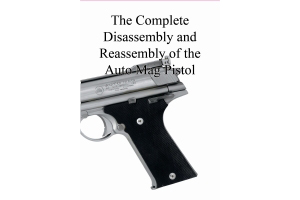
It gives me
great pleasure to reintroduce Chapter 1 of my total book of Auto Mag.
Let me first
thank the many folks who have already purchased Chapter 1 in both
sizes: 8 1/2 X
11 and 11 X 17.
The feedback
has been more than encouraging. Most
if
not all seemed to enjoy my endeavor and they are looking forward to the
new
releases of Chapter 2 and 3.
Chapter 1
deals with the earliest history of the Auto Mag and it contains photos
and
documents that go back to the original XPs produced by Max Gera.
The Chapter 1 book starts out with a 3D print of a couple of Auto Mags and the 1900 Mars pistol on the cover. The title, hand calligraphied in gold ink, reads: “The Life and Death of Auto Mag Harry W. Sanford’s Bold Adventure”.
The
historical narrative begins with a full page color photograph of a most
beautifully engraved Auto Mag.
It goes on
to give the reader a fairly comprehensive look at the experimental
prototypes
and the XPs that ultimately led to its production in Pasadena. There are layers upon
layers of historical
occurrences and many documents to authenticate the photographs included. This Chapter took
approximately 12 years to
complete. Chapter 2
would have taken
only 3 years to complete.
The cost of
Chapter
1 for the 8 1/2 X 11 is $400 and the 11 X17 is $700 plus shipping and
handling U.
S. Post Office Priority Mail.
Each book is
produced as needed from the finest archival double sided photo paper. The inkjet color copies
are exquisite. The
front and back covers are from thick
matte board and the bindings are of the spiral type.
You need to see and hold it to appreciate the
complexity of the completed package.
Now let’s
talk about Chapter 2! It
is finished and ready for sale. The
same format will be used, but since there
was so much more material available, photographs and documents, Chapter
2 will
be presented in 2 parts, A and B.
They
will be sold separately or together for a bit of a price break!
The single
copy of the 8 1/2 X 11 is $400 including shipping and handling for the
U.S. for
part A or B. The 11
X 17 is $700 including
shipping and handling for the U.S.
The cost as a pair, the whole Chapter including parts A and B is: $750 for the 8 1/2 X 11 size and $1300 including shipping and handling for the 11 X 17 size. Shipping is through USPS Priority Mail
The cover
page of part A again will be of matte board and hand done gold
calligraphy with
a collage of all of the Auto Mag advertisements done by the corporation.
Chapter 2
part Bs cover will show a collage of all of the magazine covers that
show a
photograph of an Auto Mag pistol.
After
that, you will be informed by photographs and documents that encompass
the
production at Pasadena and North Hollywood.
My writing style is easy to understand.
Any important parts of the guns, etc. will be
annotated and
explained. Chapter
2 will contain
photographs of the Auto Mag pistols that were made at the Pasadena
factory and
Bob Barbasiewicz’s garage, then just into the new factory at El Monte,
California with the last of the North Hollywood production.
Expect to
see factory engraved Auto Mags, the rare .45ACP Auto Mags and their
brief
history. Also look
for the ammunition
section where I deal with the many varied ammunition and die sets.
Chapter 2 also contains bonus content. On the back cover of Part B are two DVDs. One is the Disassembly DVD that is mentioned above, the other is filled with scans of the original serial number run ledgers, the full ballistic and testing report, and a full run of the Jurras newsletter.
Any
interested gun aficionados who collect gun books, any Auto Mag
collectors or
history buffs should surely fall in love with these historical chapters!
While perusing Chapter 2 of my book, I fell upon an interesting write up by Lee Jurras describing what happens when the accelerator digs into the frame and then stops digging, (see chapter 2 part B page 169). I called Jurras and asked when he came up with these facts. He said that he had read Max Gera's assessment in September of 2012 after I had sent him a page to review that had Gera's write up on it. That page , that was somehow overlooked for inclusion in chapter 2, will now be featured in chapter 3. The following is a sneak peek at that page with Gera's explanation. Also note the excerpt from Lee Jurras' chapter 2 article and the page it is from.
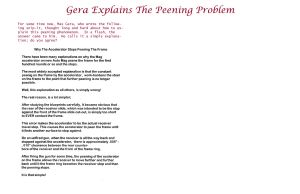
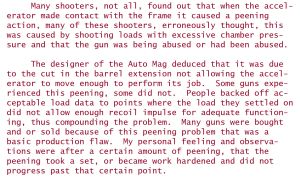
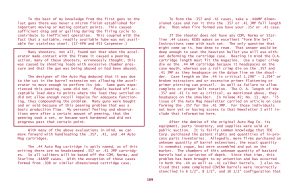
Please make your desire known to me on my email at bert@automagheaven.com!
Please click here to comment in the Guestbook. For last month's site click here.
